Influence of Cutting Parameters on the Surface Quality of Two-Layer Sandwich Structures
Abstract
1. Introduction
2. Materials and Methods
- X
- —the defect value (μm),
- XCFRP
- —the cross profile of the unevenness formed on the surface of the composite (μm),
- XAl
- —the cross profile of the unevenness formed on the surface of the aluminum alloy (μm).
3. Results
3.1. Cutting Speed (Vc) Effects on the Value of the Defect
3.2. Feed (fz) Effects on the Value of the Defect
3.3. Cutting width (ae) Effects on the Value of the Defect
4. Discussion
5. Conclusions
Author Contributions
Funding
Conflicts of Interest
References
- Oluwarotimi, S.; Nath, H.; Popov, I.; Beaugrand, J. Comprehensive study on machinability of sustainable and conventional fibre reinforced polymer composites. Eng. Sci. Technol. Int. J. 2016, 19, 2043–2052. [Google Scholar] [CrossRef]
- Nor, A.; Burbon, W.; Bert, C. Computation models for sandwich panels and shells. Appl. Mech. Rev. 1996, 49, 155–199. [Google Scholar] [CrossRef]
- Prasad, D.S.; Shoba, C.H. Hybrid composites—A better choice for high wear resistance materials. J. Mater. Res. Technol. 2014, 3, 172–178. [Google Scholar] [CrossRef]
- Mamalis, M.; Spentzas, K.; Pantelelis, N.; Manolakos, D.; Ioannidis, M. A new hybrid concept for sandwich structures. Compos. Struct. 2008, 83, 335–340. [Google Scholar] [CrossRef]
- Lu, H.; Wang, X.; Zhang, T.; Cheng, Z.; Fang, Q. Design, fabrication, and properties of high damping metal matrix composites—A review. Materials 2009, 2, 958–977. [Google Scholar] [CrossRef]
- Botelho, E.C.; Pardini, L.C.; Rezende, M.C. Hydrothermal, effects on damping behavior of metal/glass fiber/epoxy hybrid composites. Mater. Sci. Eng. A 2005, 399, 190–198. [Google Scholar] [CrossRef]
- Vamja, D.; Tejani, G. Experimental test on sandwich panel. Composite material. IJIRSET 2013, 2, 3047–3054. [Google Scholar] [CrossRef]
- Icardi, U.; Ferrero, L. Optimization of sandwich panels with functionally graded core and faces. Compos. Sci. Technol. 2009, 69, 575–585. [Google Scholar] [CrossRef]
- Zhou, D.; Stronge, W. Mechanical properties of fibrous core sandwich panels. Int. J. Mech. Sci. 2005, 47, 775–798. [Google Scholar] [CrossRef]
- Arbaoui, J.; Schmitt, Y.; Pierrot, J.L.; Royer, F.X. Effect of core thickness and intermediate layers on mechanical properties of polypropylene honey comb multilayer sandwich structures. Arch. Metall. Mater. 2014, 59, 11–16. [Google Scholar] [CrossRef]
- Daniel, I.M. Influence of core properties on the failure of composite sandwich beams. J. Mech. Mater. Struct. 2009, 4, 1271–1286. [Google Scholar] [CrossRef]
- Hýsek, Š.; Frydrych, M.; Herclík, M.; Louda, P.; Fridrichová, L.; Le Van, S.; Le Chi, H. Fire-Resistant Sandwich-Structured Composite Material Based on Alternative Materials and Its Physical and Mechanical Properties. Materials 2019, 12, 1432. [Google Scholar] [CrossRef] [PubMed]
- Hýsek, Š.; Frydrych, M.; Herclík, M.; Fridrichová, L.; Louda, P.; Kníže, R.; Le Van, S.; Le Chi, H. Permeable Water-Resistant Heat Insulation Panel Based on Recycled Materials and Its Physical and Mechanical Properties. Molecules 2019, 24, 3300. [Google Scholar] [CrossRef] [PubMed]
- Feito, N.; Diaz-Alvarez, J.; Lopez-Puente, J.; Miguelez, M.H. Nimerical analysis of the influence of tool wear and special cutting geometry when drilling woven CFRPs. Compos. Struct. 2016, 138, 258–294. [Google Scholar] [CrossRef]
- Lopresto, V.; Caggiano, A.; Teti, R. High Performance Cutting of Fibre Reinforced Plastic Composite Materials. Procedia CIRP 2016, 46, 71–82. [Google Scholar] [CrossRef]
- Yue, X.; Yang, X.; Tian, J.; He, Z.; Fan, Y. Thermal, mechanical and chemical material removal mechanism of carbon fiber reinforced polymers in electrical discharge machining. Int. J. Mach. Tool Manuf. 2018, 133, 4–17. [Google Scholar] [CrossRef]
- Zitoune, R.; Krishnaraj, V.; Collombet, F. Study of drilling of composite material and aluminium stack. Compos. Struct. 2010, 95, 1246–1255. [Google Scholar] [CrossRef]
- Zhang, L.; Liu, Z.; Tian, W.; Liao, W. Experimental studies on the performance of different structure tools in drilling CFRP/Al alloy stacks. Int. J. Adv. Manuf. Technol. 2015, 81, 241–251. [Google Scholar] [CrossRef]
- Nataraj, M.; Balasubramanian, K. Parametric optimization of CNC turning process for hybrid metal matrix composite. Int. J. Adv. Manuf. Tech. 2017, 93, 1–4. [Google Scholar] [CrossRef]
- Carlsson, L.A.; Kardomateas, G.A. Structural and Failure Mechanics of Sandwich Composites, 1st ed.; Springer: New York, NY, USA, 2011. [Google Scholar]
- Kulkarni, P. Evaluation of mechanical properties of Al 2024 based hybrid metal composites. J. Mech. Civ. Eng. 2015, 12, 108–122. [Google Scholar] [CrossRef]
- PN-EN. 573-3: 2019-12: Aluminum and Aluminum Alloys. Chemical Composition and Form of Wrought Products. Part 3: Chemical Composition and Form of Products; PN-EN: Warsaw, Poland, 2019. [Google Scholar]
- DIN EN. 2563: Luft—und Raumfahrt—Kohlenstoffaserverstärkte Kunststoffe—Unidirektionale Laminate; Bestimmung der Scheinbaren Interlaminaren Scherfestigkeit; DIN EN: Berlin, Germany, 1997. [Google Scholar]
- DIN ISO. 527: Kunststoffe—Bestimmung der Zugeigenschaften—Teil 1: Allgemeine Grundsätze; DIN ISO: Berlin, Germany, 2012. [Google Scholar]
- DIN ISO. 14125: Faserverstärkte Kunststoffe—Bestimmung der Biegeeigenschaften; DIN ISO: Berlin, Germany, 2011. [Google Scholar]
- Hoffmann Group. Catalogue 1 Machining/Clamping Technology; Hoffmann Group: Munich, Germany, 2019. [Google Scholar]
- Mishra, P.; Pandey, C.M.; Singh, U.; Gupta, A.; Sahu, C.; Keshri, A. Descriptive statistics and normality tests for statistical data. Ann. Card. Anaesth. 2019, 22, 67–72. [Google Scholar] [CrossRef] [PubMed]
- Benjamin, D.J.; Berger, J.O.; Johannesson, M.; Nosek, B.A.; Wagenmakers, E.J.; Berk, R.; Cesarini, D. Redefine statistical significance. Nat. Hum. Behav. 2018, 2, 6–10. [Google Scholar] [CrossRef] [PubMed]
- Slamin, M.; Gauthier, S.; Chatelain, J.-F. Analysis of trajectory deviation during high speed trimming of carbon-fiber reinforced polymers. Robot. CIM-Int. Manuf. 2014, 30, 546–555. [Google Scholar] [CrossRef]
- Uhlmann, E.; Richciarz, S.; Sammler, F.; Hufschmied, R. High Speed Cutting of Carbon Fibre Reinforced Plastics. Procedia Manuf. 2016, 6, 113–123. [Google Scholar] [CrossRef]
- Gara, S.; Tsoumarev, O. Effect of tool geometry on surface roughness in slotting of CFRP. Int. J. Adv. Manuf. Technol. 2016, 86, 451–461. [Google Scholar] [CrossRef]
- Azmi, A.J.; Lin, R.J.T.; Bhattacharyya, D. Machinability study of glass fibre-reinforces polymer composites during end milling. Int. J. Adv. Manuf. Technol. 2013, 64, 247–261. [Google Scholar] [CrossRef]
- Boudelier, A.; Ritou, M.; Garnier, S.; Furet, B. Optimization of process parameters in CFRP machining with diamond abrasive cutters. Adv. Mater. Res. 2011, 223, 774–783. [Google Scholar] [CrossRef]
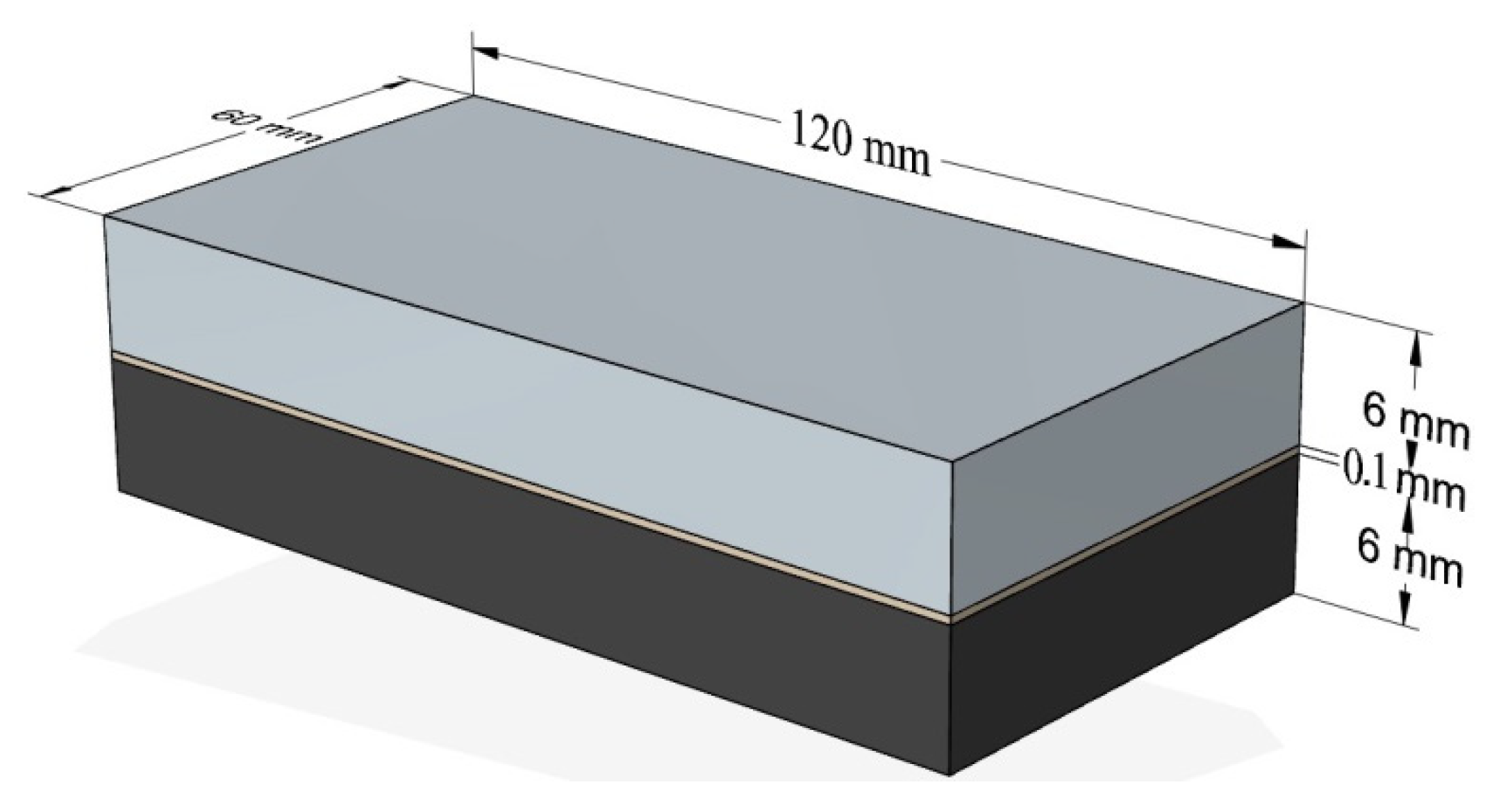
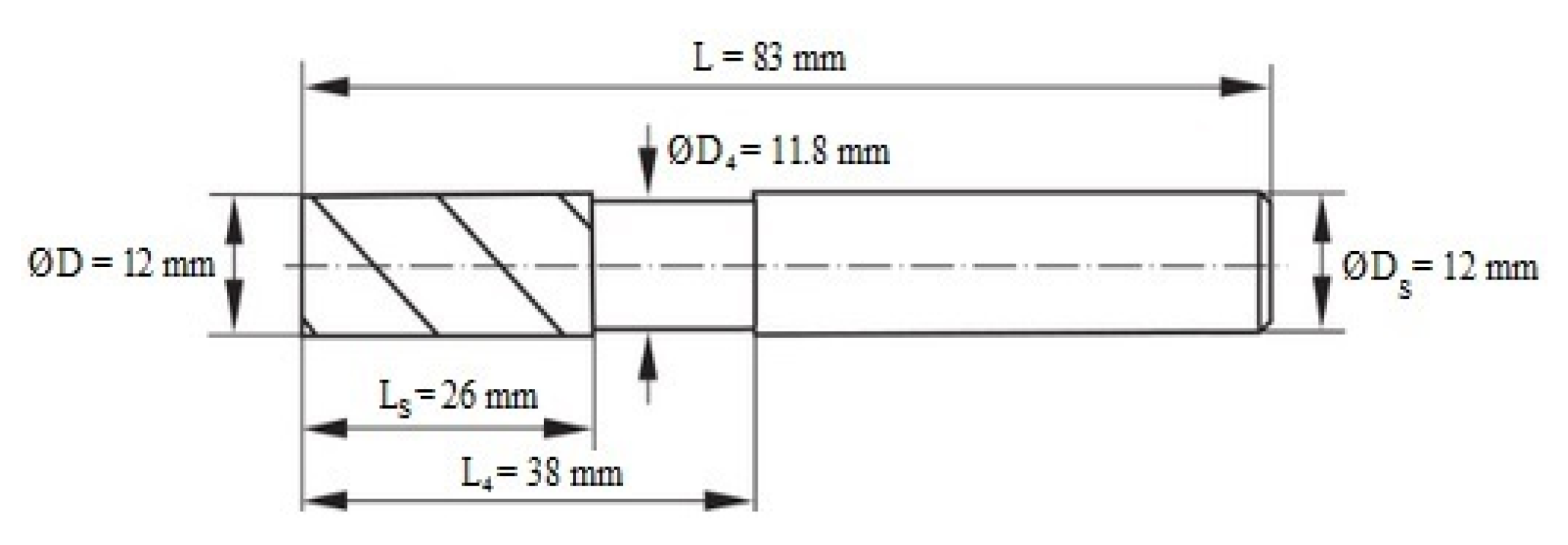
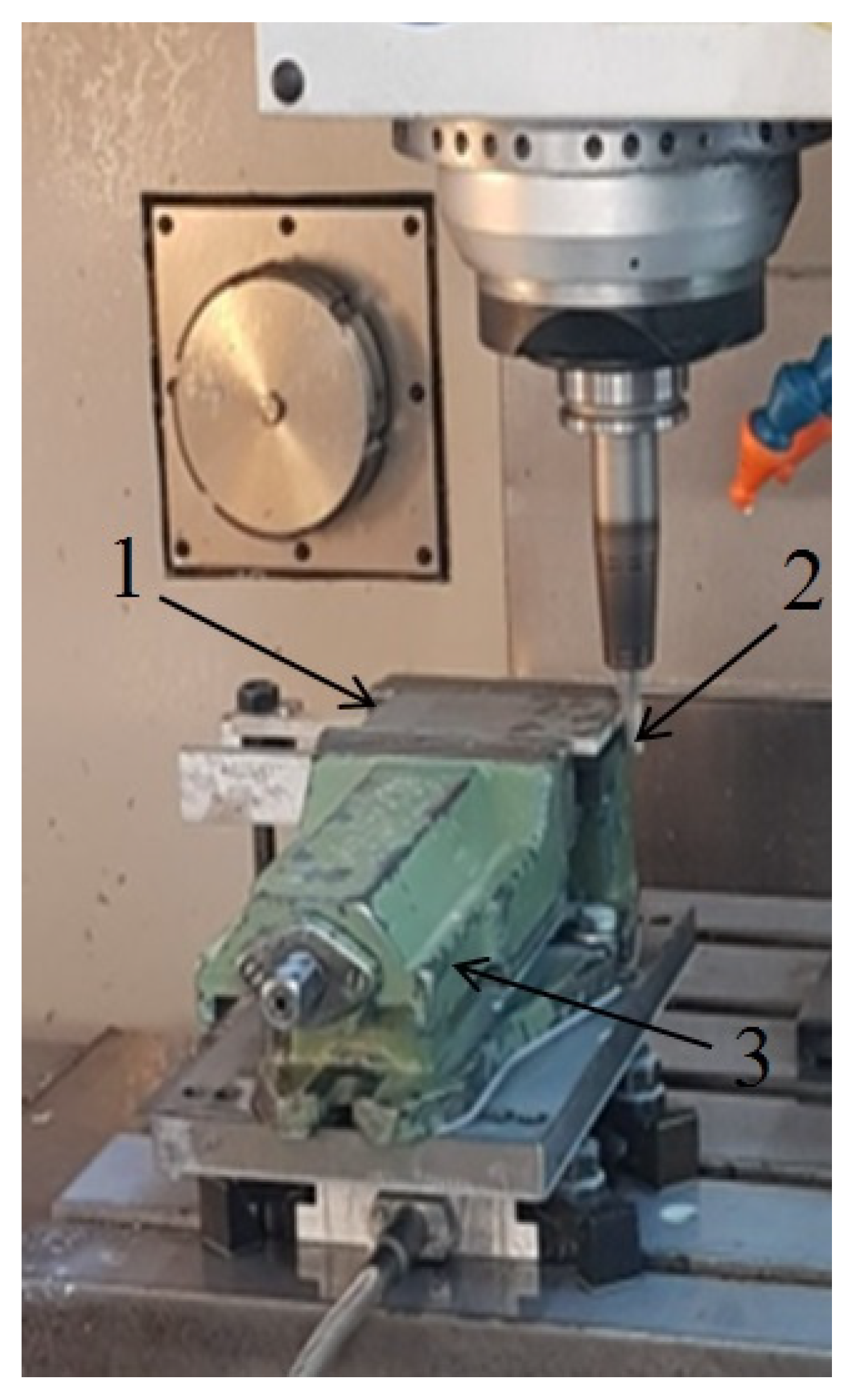

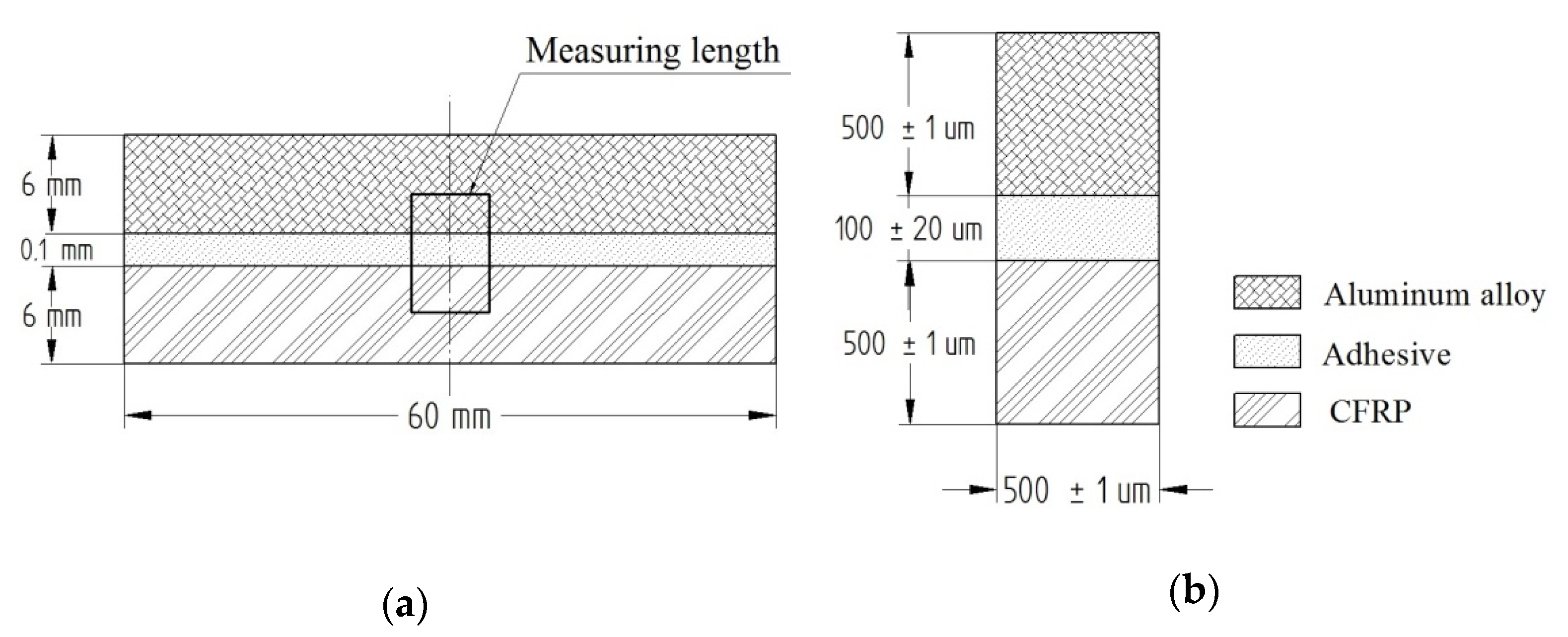
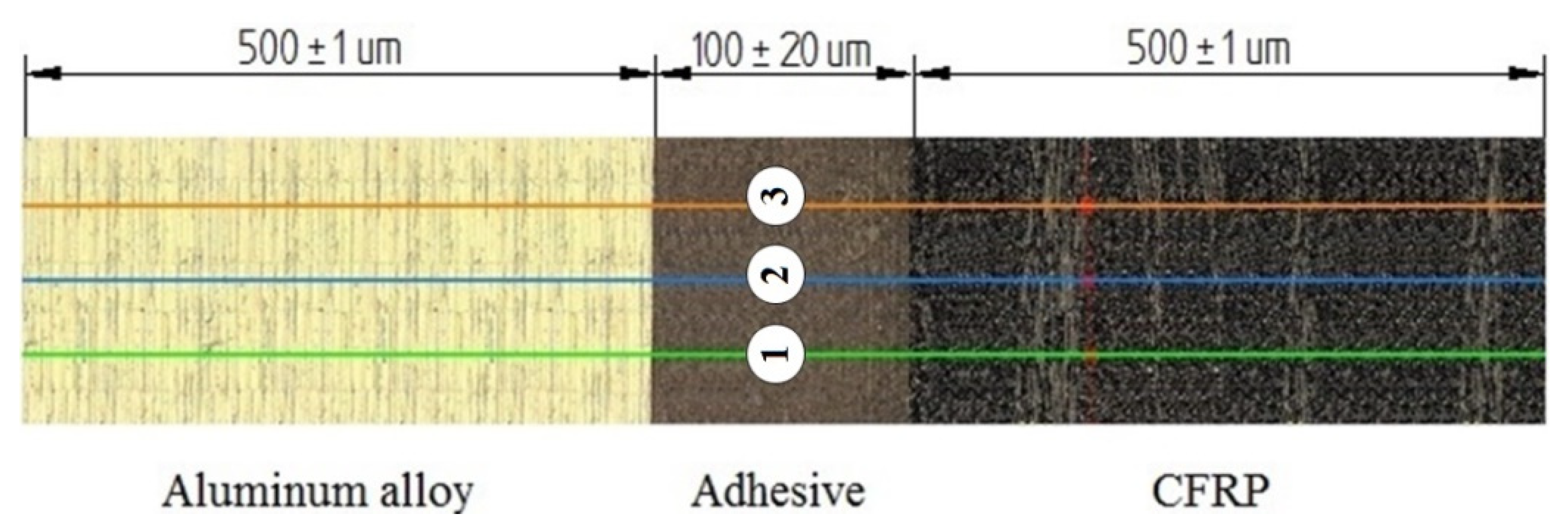
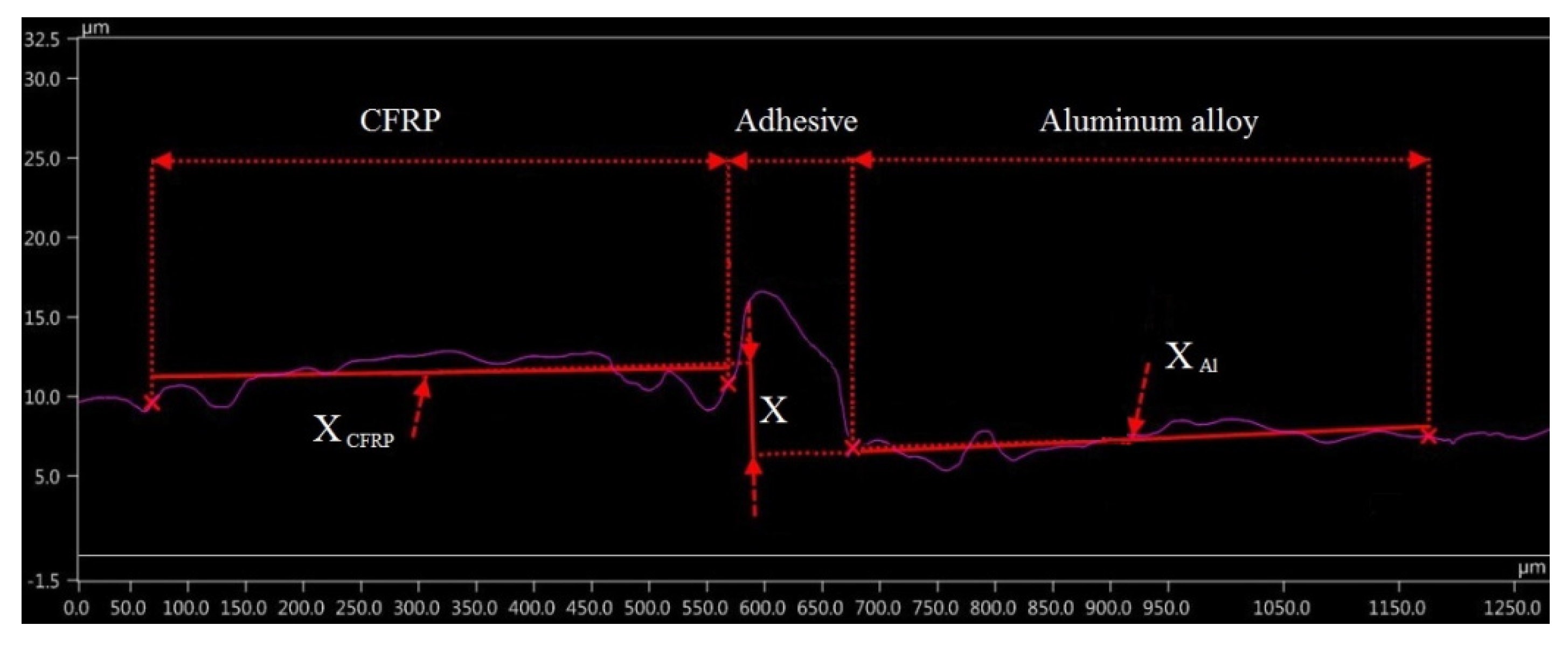
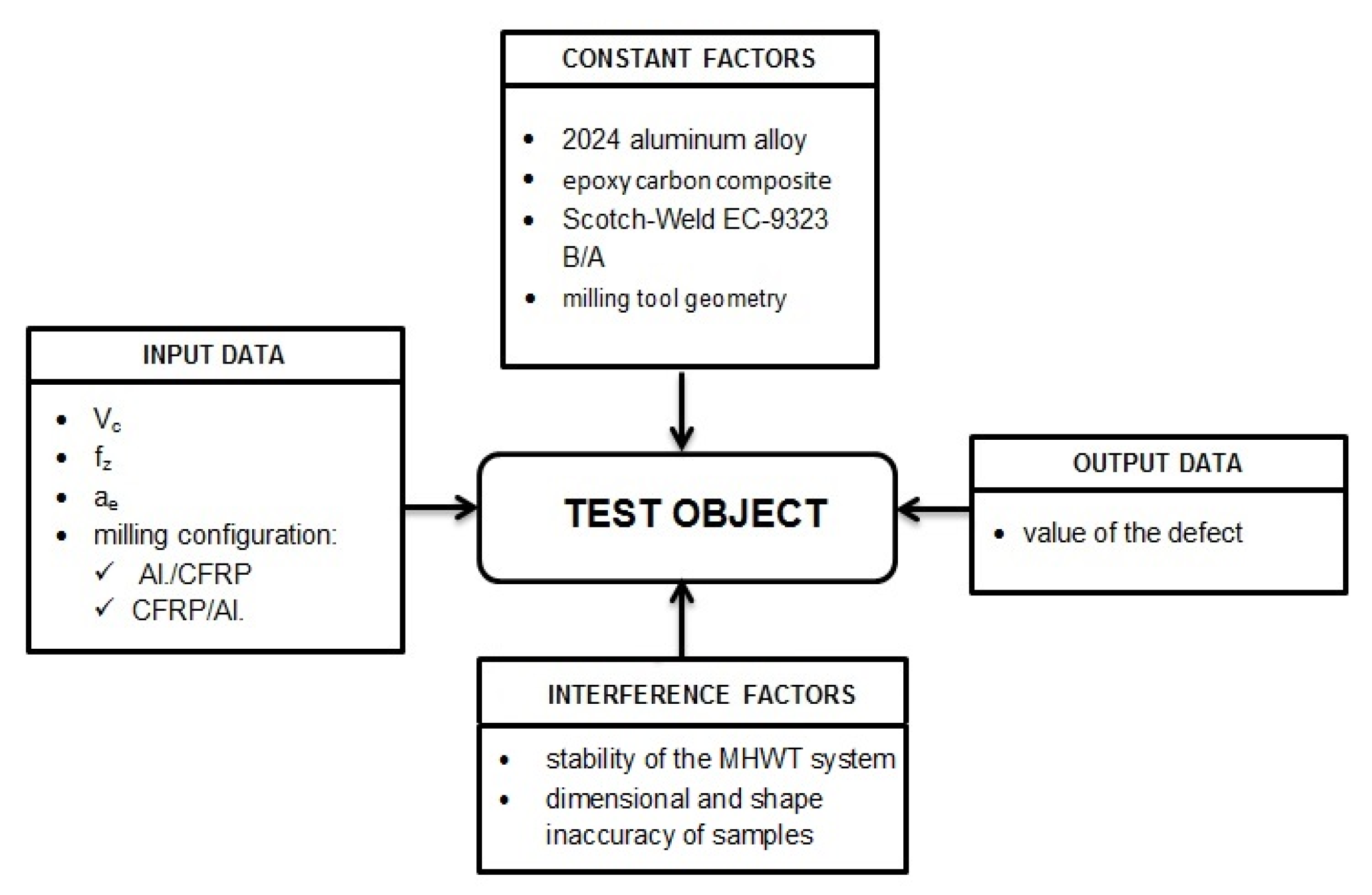
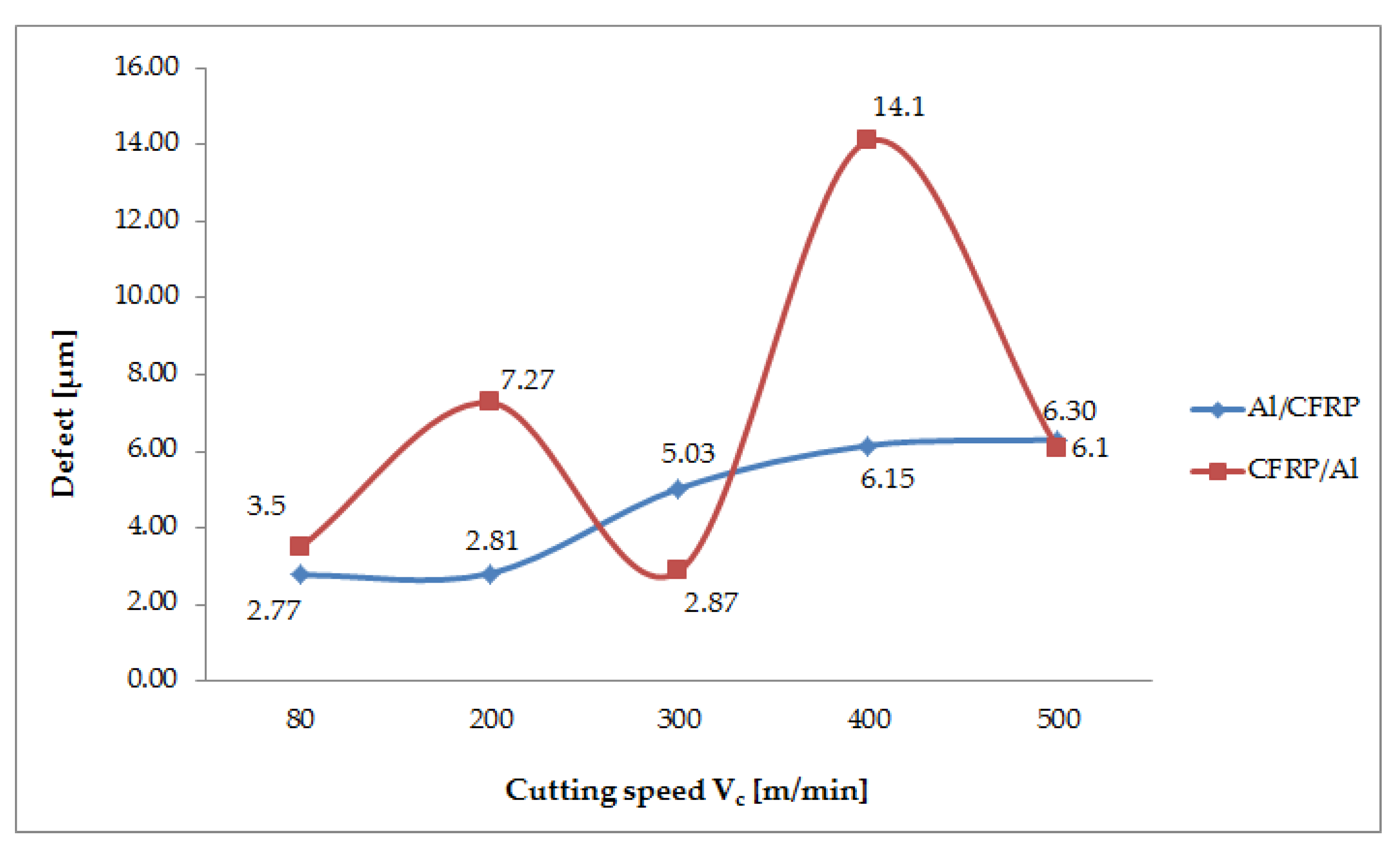
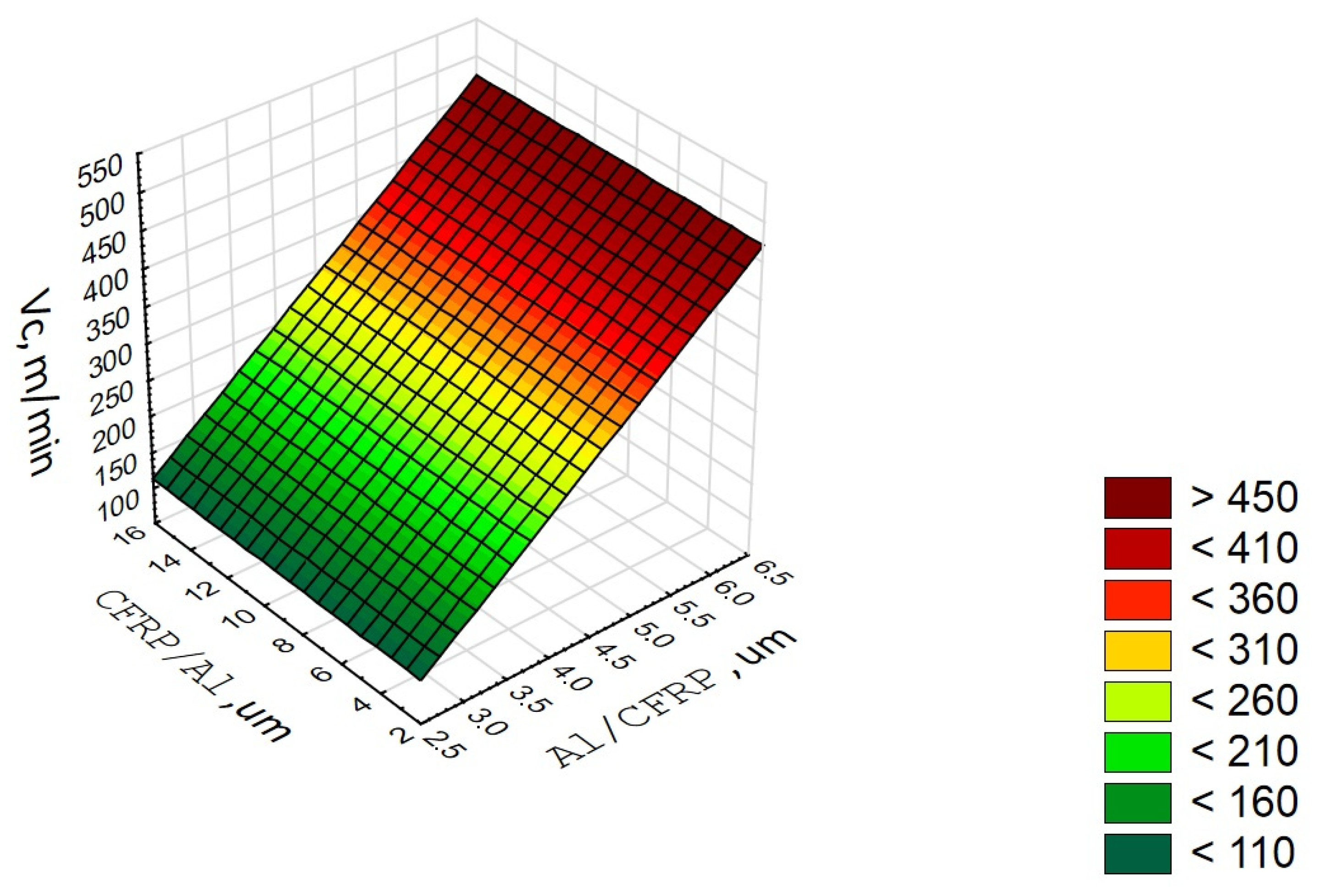
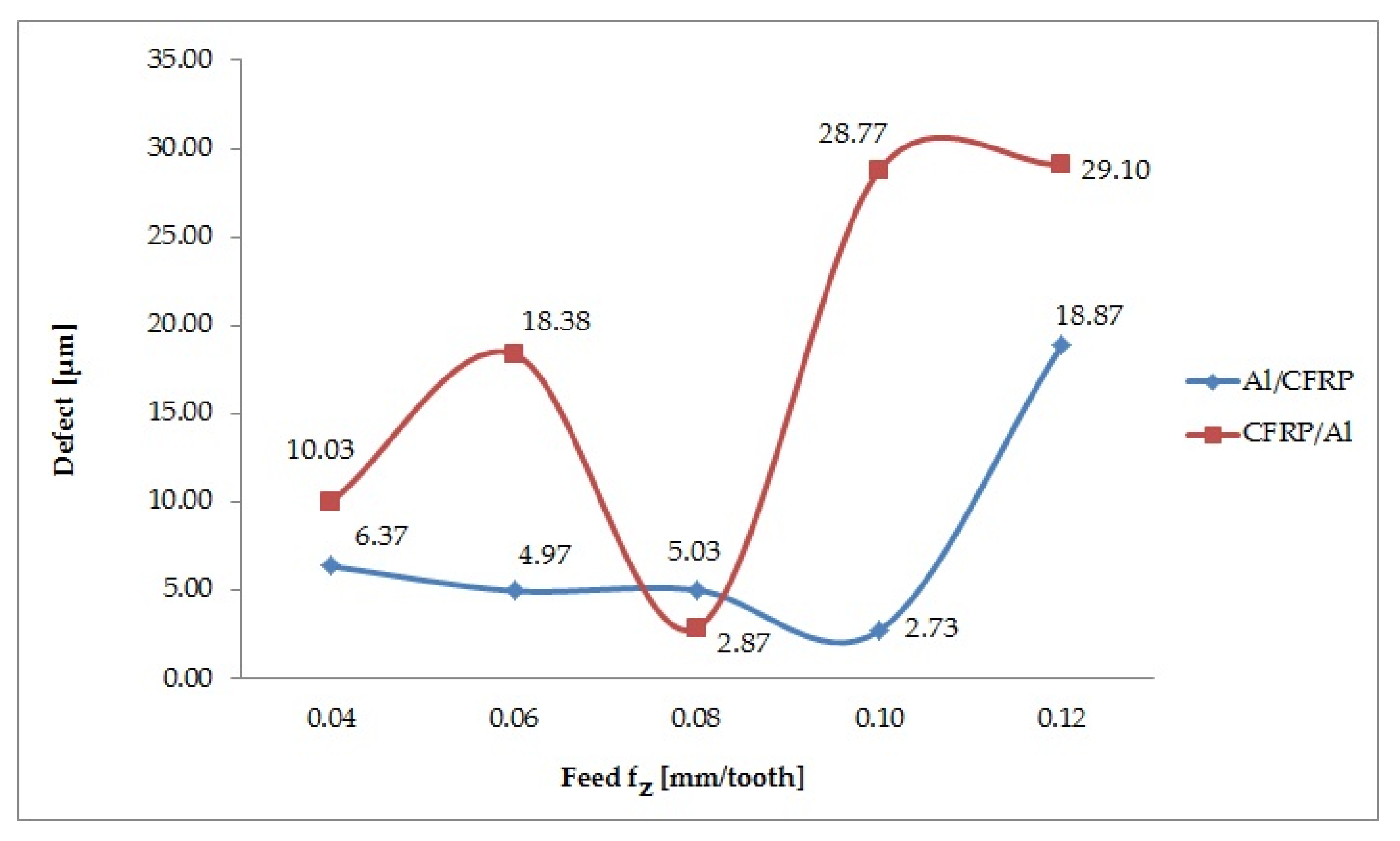


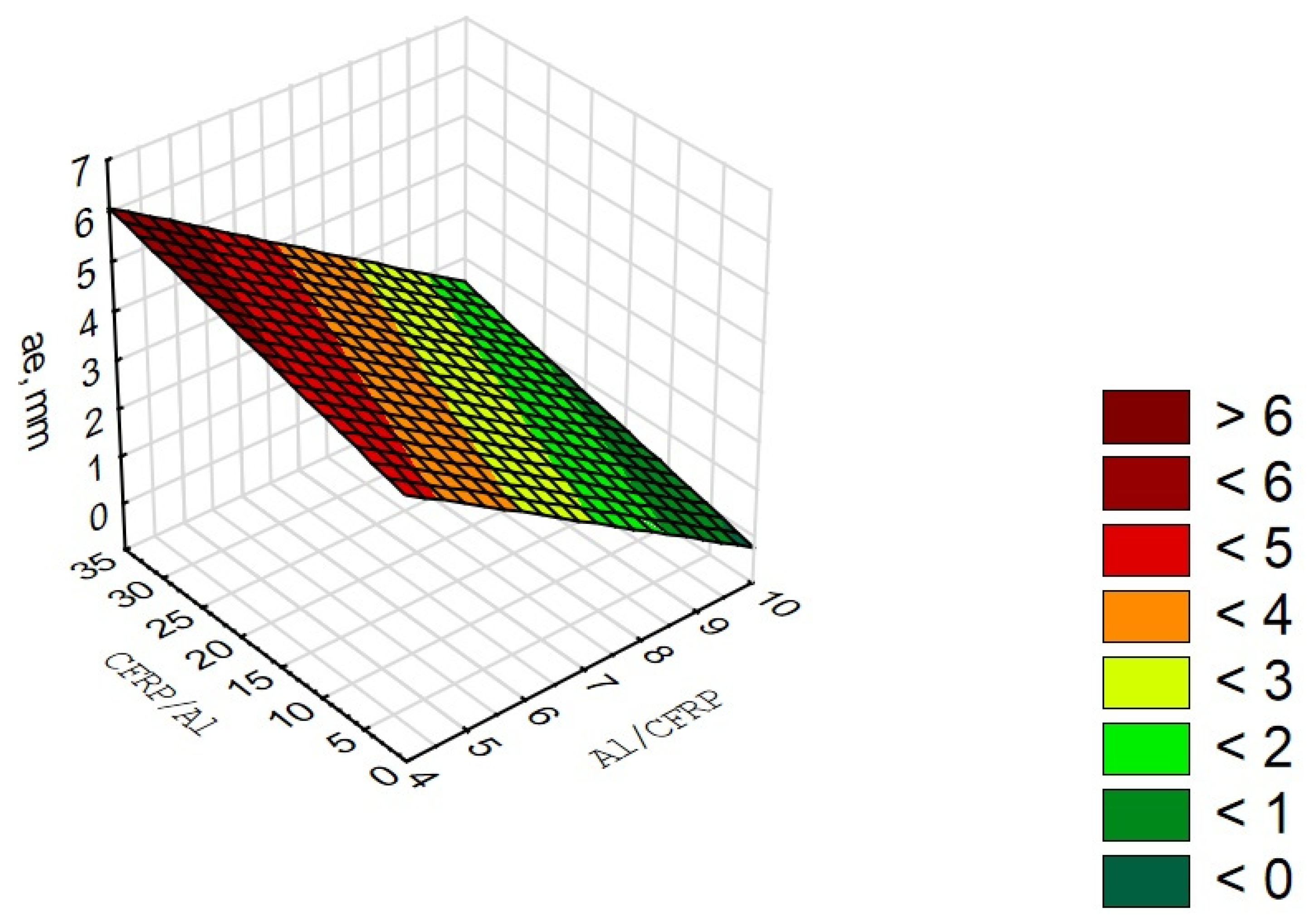
| Element | Si | Fe | Mg | Cu | Mn | Zn | Cr | Zr+Ti | Other | Al |
|---|---|---|---|---|---|---|---|---|---|---|
| Composition (%) | ≤0.5 | ≤0.5 | 1.5 | 4.2 | 0.6 | ≤0.25 | ≤0.1 | ≤0.2 | ≤0.15 | rest |
| Tensile strength 0° | 1100 MPa |
| E-Modulus 0° | 70 GPa |
| Flexural strength | 1050 MPa |
| Flexural-Modulus 0° | 62 GPa |
| ILSF | 70 MPa |
| Variable: Vc (m/min) | Vc = 80 | fz = 0.08 | ae = 4 |
| Vc = 200 | fz = 0.08 | ae = 4 | |
| Vc = 300 | fz = 0.08 | ae = 4 | |
| Vc = 400 | fz = 0.08 | ae = 4 | |
| Vc = 500 | fz = 0.08 | ae = 4 | |
| Variable: fz (mm/tooth) | Vc = 300 | fz = 0.04 | ae = 4 |
| Vc = 300 | fz = 0.06 | ae = 4 | |
| Vc = 300 | fz = 0.08 | ae = 4 | |
| Vc = 300 | fz = 0.10 | ae = 4 | |
| Vc = 300 | fz = 0.12 | ae = 4 | |
| Variable: ae (mm) | Vc = 300 | fz = 0.08 | ae = 1 |
| Vc = 300 | fz = 0.08 | ae = 2 | |
| Vc = 300 | fz = 0.08 | ae = 3 | |
| Vc = 300 | fz = 0.08 | ae = 4 | |
| Vc = 300 | fz = 0.08 | ae = 5 |
| Test | Hypothesis | Set of Critical Values |
|---|---|---|
| Fisher-Snedecor | H0: H1: | W = < |
| Student’s t-test | H0: H1: | W = ( |
| Cochran-Cox | H0: H1: | W = ( |
| Variable | Configuration | |||||
|---|---|---|---|---|---|---|
| Al/CFRP | CFRP/Al | |||||
| Wα | W | p | Wα | W | p | |
| Vc = 80 | 0.77 | 0.98 | 0.66 | 0.77 | 0.96 | 0.59 |
| Vc = 200 | 0.77 | 0.95 | 0.58 | 0.77 | 0.87 | 0.30 |
| Vc = 300 | 0.77 | 0.99 | 0.80 | 0.77 | 0.99 | 0.78 |
| Vc = 400 | 0.77 | 0.99 | 0.96 | 0.77 | 0.99 | 0.95 |
| Vc = 500 | 0.77 | 0.80 | 0.12 | 0.77 | 0.95 | 0.58 |
| Compared Parameters | Fischer-Snedecor Test | Student’s t-Test | ||||
|---|---|---|---|---|---|---|
| F | Fα Critical Value | Result | t Statistics Value | tα Critical Value | Result | |
| Statistics Value | ||||||
| Vc80–Vc200 | 7.14 | 19.00 | 0.47 | 2.78 | ||
| Vc80–Vc300 | 1.72 | 19.00 | −1.76 | 2.78 | ||
| Vc80–Vc400 | 1.46 | 19.00 | −2.09 | 2.78 | ||
| Vc80–Vc500 | 1.21 | 19.00 | −2.35 | 2.78 | ||
| Vc200–Vc300 | 4.16 | 19.00 | −3.17 | 2.78 | ||
| Vc200–Vc400 | 10.43 | 19.00 | −2.98 | 2.78 | ||
| Vc200–Vc500 | 5.19 | 19.00 | −3.73 | 2.78 | ||
| Vc300–Vc4000 | 2.51 | 19.00 | −0.75 | 2.78 | ||
| Vc300–Vc500 | 1.42 | 19.00 | −0.82 | 2.78 | ||
| Vc400–Vc500 | 1.76 | 19.00 | 0.06 | 2.78 | ||
| Compared Parameters | Fischer-Snedecor Test | Student’s t-Test | ||||
| F Statistics Value | Fα Critical Value | Result | t Statistics Value | tα Critical Value | Result | |
| Vc80–Vc200 | 1.62 | 19.00 | −3.13 | 2.78 | ||
| Vc80–Vc400 | 3.71 | 19.00 | −5.17 | 2.78 | ||
| Vc80–Vc500 | 1.93 | 19.00 | −2.23 | 2.78 | ||
| Vc200–Vc400 | 6.01 | 19.00 | −3.48 | 2.78 | ||
| Vc200–Vc500 | 1.19 | 19.00 | 6.10 | 2.78 | ||
| Vc400–Vc500 | 7.14 | 19.00 | 4.12 | 2.78 | ||
| Compared Parameters | Fischer-Snedecor Test | Cochran Cox-Test | ||||
| F Statistics Value | Fα Critical Value | Result | C Statistics Value | Cα Critical Value | Result | |
| Vc80–Vc200 | 42.32 | 19.00 | 2.60 | 4.30 | ||
| Vc200–Vc300 | 26.11 | 19.00 | 4.75 | 4.30 | ||
| Vc300–Vc400 | 156.79 | 19.00 | 5.02 | 4.30 | ||
| Vc300–Vc500 | 21.95 | 19.00 | 3.36 | 4.30 | ||
| Variable | Configuration | |||||
|---|---|---|---|---|---|---|
| Al/CFRP | CFRP/Al | |||||
| Wα | W | p | Wα | W | p | |
| fz = 0.04 | 0.77 | 0.87 | 0.30 | 0.77 | 0.99 | 0.90 |
| fz = 0.06 | 0.77 | 0.99 | 0.96 | 0.77 | 0.96 | 0.64 |
| fz = 0.08 | 0.77 | 0.99 | 0.80 | 0.77 | 0.99 | 0.78 |
| fz = 0.10 | 0.77 | 0.88 | 0.33 | 0.77 | 0.78 | 0.77 |
| fz = 0.12 | 0.77 | 0.93 | 0.60 | 0.77 | 0.75 | 0.00 |
| Compared parameters | Fischer-Snedecor Test | Student’s t-Test | ||||
| F Statistics Value | Fα Critical Value | Result | t Statistics Value | tα Critical Value | Result | |
| fz0.04–fz0.08 | 17.84 | 19.00 | 1.66 | 2.77 | ||
| fz0.04–fz0.1 | 3.32 | 19.00 | 9.42 | 2.77 | ||
| fz0.06–fz0.08 | 4.26 | 19.00 | 0.04 | 2.77 | ||
| fz0.06–fz0.12 | 3.21 | 19.00 | −5.28 | 2.77 | ||
| fz0.08–fz0.1 | 5.37 | 19.00 | 2.69 | 2.77 | ||
| fz0.08–fz0.12 | 13.68 | 19.00 | −5.82 | 2.77 | ||
| fz0.1–fz0.12 | 5.02 | 19.00 | −6.77 | 2.77 | ||
| Compared Parameters | Fischer-Snedecor Test | Cochran Cox-Test | ||||
| F Statistics Value | Fα Critical Value | Result | C Statistics Value | Cα Critical Value | Result | |
| fz0.04–fz0.06 | 75.90 | 19.00 | 0.70 | 4.30 | ||
| fz0.04–fz0.12 | 243.97 | 19.00 | 8.98 | 4.30 | ||
| fz0.06–fz0.1 | 22.85 | 19.00 | 1.10 | 4.30 | ||
| Compared Parameters | Fischer-Snedecor Test | Student’s t-Test | ||||
| F Statistics Value | Fα Critical Value | Result | t Statistics Value | tα Critical Value | Result | |
| fz0.04–fz0.06 | 9.19 | 19.00 | −8.22 | 2.77 | ||
| fz0.04–fz0.08 | 4.79 | 19.00 | 20.50 | 2.77 | ||
| fz0.04–fz0.1 | 5.09 | 19.00 | −23.88 | 2.77 | ||
| fz0.06–fz0.1 | 1.81 | 19.00 | −8.65 | 2.77 | ||
| Compared Parameters | Fischer-Snedecor Test | Cochran Cox-Test | ||||
| F Statistics Value | Fα Critical Value | Result | C Statistics Value | Cα Critical Value | Result | |
| fz0.06–fz0.08 | 44.00 | 19.00 | 12.99 | 4.30 | ||
| fz0.08–fz0.1 | 24.37 | 19.00 | 28.90 | 4.30 | ||
| Variable | Configuration | |||||
|---|---|---|---|---|---|---|
| Al/CFRP | CFRP/Al | |||||
| Wα | W | p | Wα | W | p | |
| ae = 1 | 0.77 | 0.75 | 0.00 | 0.77 | 0.92 | 0.43 |
| ae = 2 | 0.77 | 0.93 | 0.49 | 0.77 | 0.99 | 0.92 |
| ae = 3 | 0.77 | 0.78 | 0.07 | 0.77 | 0.90 | 0.38 |
| ae = 4 | 0.77 | 0.99 | 0.80 | 0.77 | 0.99 | 0.86 |
| ae = 5 | 0.77 | 0.99 | 0.77 | 0.77 | 0.99 | 0.87 |
| Compared Parameters | Fischer-Snedecor Test | Student’s t-Test | ||||
|---|---|---|---|---|---|---|
| F Statistics Value | Fα Critical Value | Result | t Statistics Value | tα Critical Value | Result | |
| ae2–ae3 | 19.00 | 2.07 | 2.77 | 2.78 | ||
| ae2–ae4 | 19.00 | 1.90 | 2.77 | 4.72 | ||
| ae2–ae5 | 19.00 | 6.02 | 2.77 | 2.83 | ||
| ae3–ae4 | 19.00 | 1.09 | 2.77 | 1.59 | ||
| ae3–ae5 | 19.00 | 2.42 | 2.77 | 0.93 | ||
| ae4–ae5 | 19.00 | 3.17 | 2.77 | −0.19 | ||
| Compared Parameters | Fischer-Snedecor Test | Student’s t-Test | ||||
| F Statistics Value | Fα Critical Value | Result | t Statistics Value | tα Critical Value | Result | |
| ae1–ae2 | 1.87 | 19.00 | −18.19 | 2.77 | ||
| ae1–ae3 | 1.27 | 19.00 | 11.30 | 2.77 | ||
| ae1–ae4 | 12.47 | 19.00 | 24.25 | 2.77 | ||
| ae2–ae3 | 2.37 | 19.00 | 29.44 | 2.77 | ||
| ae2–ae4 | 6.68 | 19.00 | 60.83 | 2.77 | ||
| ae3–ae4 | 15.84 | 19.00 | 7.04 | 2.77 | ||
| Compared Parameters | Fischer-Snedecor Test | Cochran Cox-Test | ||||
| F Statistics Value | Fα Critical Value | Result | C Statistics Value | Cα Critical Value | Result | |
| ae1–ae5 | 708.32 | 19.00 | 0.44 | 4.30 | ||
| ae2–ae5 | 1321.83 | 19.00 | 0.35 | 4.30 | ||
| ae3–ae5 | 557.71 | 19.00 | 1.56 | 4.30 | ||
| ae4–ae5 | 8835.37 | 19.00 | 1.81 | 4.30 | ||
© 2020 by the authors. Licensee MDPI, Basel, Switzerland. This article is an open access article distributed under the terms and conditions of the Creative Commons Attribution (CC BY) license (http://creativecommons.org/licenses/by/4.0/).
Share and Cite
Doluk, E.; Rudawska, A.; Kuczmaszewski, J.; Pieśko, P. Influence of Cutting Parameters on the Surface Quality of Two-Layer Sandwich Structures. Materials 2020, 13, 1664. https://doi.org/10.3390/ma13071664
Doluk E, Rudawska A, Kuczmaszewski J, Pieśko P. Influence of Cutting Parameters on the Surface Quality of Two-Layer Sandwich Structures. Materials. 2020; 13(7):1664. https://doi.org/10.3390/ma13071664
Chicago/Turabian StyleDoluk, Elżbieta, Anna Rudawska, Józef Kuczmaszewski, and Paweł Pieśko. 2020. "Influence of Cutting Parameters on the Surface Quality of Two-Layer Sandwich Structures" Materials 13, no. 7: 1664. https://doi.org/10.3390/ma13071664
APA StyleDoluk, E., Rudawska, A., Kuczmaszewski, J., & Pieśko, P. (2020). Influence of Cutting Parameters on the Surface Quality of Two-Layer Sandwich Structures. Materials, 13(7), 1664. https://doi.org/10.3390/ma13071664








